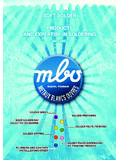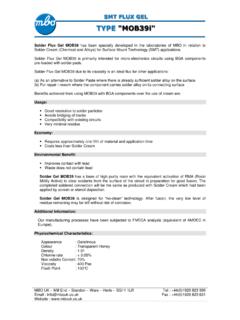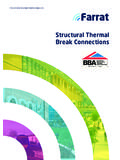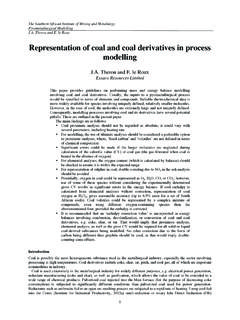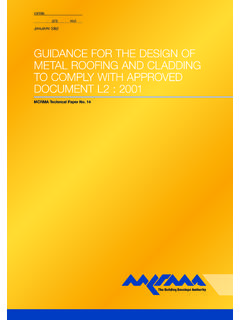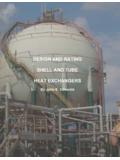Transcription of European Microelectronics and Packaging Symposium
1 European Microelectronics and Packaging SymposiumPrague 16th to 18th June 2004, Czech RepublicTHERMAL CONDUCTIVITY OF MOLTEN LEAD FREE SOLDERSJAROMIR BILEK, JOHN ATKINSON, WILLIAM WAKEHAMU niversity of Southampton, School of Engineering Sciences, Thick Film Unit,Highfield, SO17 1BJ, Southampton, United KingdomE-mail: increasing influence of computational modelling in all technologicalprocesses generates an increased demand for accurate values of the physicalproperties of the materials involved, which are used as fundamental inputsfor every the production of electronic circuits, a thorough knowledge of thethermal conductivity of molten solders can result in a better controlledsoldering process. As a result, this information can be used for setting theoptimum soldering profile and thereby lead to improvement in the qualitycontrol of the solder paper describes the principles of the experimental technique employedfor the measurement of the thermal conductivity of molten solders anddescribes the essential features of the instrumentation.
2 The values of thethermal conductivity of different lead and lead-free solder compositions,measured at various temperatures and temperature profiles, are comparedand briefly : thermal conductivity, molten solder, FE the development of computational software, most of the modern fabricationprocesses are modelled mathematically before they are implemented in production. Inalmost every production process, computation is being used to predict the behaviour ofthe components and materials during manufacturing. The importance of such modellingincreases with decreases of the dimensions of components and amounts of materials usedand with increasing integration. For meaningful modelling, the material properties mustbe very accurately defined at specific conditions and for every temperature at which thematerial is used or a component mounted. However, without knowing the exactmechanical and thermal properties , the mathematical modelling cannot result in accuratedesign and process solutions.
3 The thermal conductivity is the most important thermalproperty involved in models of thermal expansion and heat transfer phenomena. Forelectronic production, soldering and solder solidification belong to the most critical partsof the fabrication process and therefore this paper focuses on the measurement of thethermal conductivity of molten a new lead-free policy was introduced in all industries [1] and particularly inelectronics production, the research and development of lead-free soldering materials andprocesses have become an important issue. Within the last few years, several new lead-free compositions have been introduced, investigated, and main goal of this paper is to investigate both lead and lead free solders andobserve their thermal conductivity in the liquid phase throughout a range of temperaturesabove the melting point. Knowing accurate thermal conductivity values for molten soldercan significantly help to improve the fabrication process of any electronic device thatmakes use of technique with accuracy within the range 2% has been developed in the lastdecade [2] and an instrument has been designed to measure the thermal conductivity ofmolten metals.
4 This same instrument is also used for the current hot wire methodBecause the main difficulty in performing accurate measurements of the thermalconductivity of fluids lies in the isolation of the conduction process from othermechanisms of heat transfer, it is necessary to employed transient methods. Currently themost accurate transient technique is that based upon a transient hot wire method. Thesuccess of transient techniques is based on the fact that the characteristic time for theacceleration of the fluid by buoyancy forces is much longer than the propagation time ofa temperature wave originated by a strong and localised temperature gradient. Thetransient hot wire technique is an absolute technique and instruments based on itsprinciple are considered capable of providing the highest accuracy possible at present[3].The basic concept of the method is that a voltage step is applied to a hot-wire ,which is immersed in the fluid, and the resistance of the wire (or the voltage across it) ismonitored as a function of time.
5 As the wire is being heated up and its resistance isincreasing with temperature, the voltage also increases. From the changes of voltage withrespect to time, transient resistance changes and the heat flux within the fluid can becalculated. Assuming that an isotropic fluid has a temperature independent thermalconductivity, density and heat capacity over small temperature ranges, a fundamentalequation of all transient experimental methods for the measurement of the thermalconductivity can be written [3, 4]TtTCP2 (1)where is density [kg/m3], Cp is specific heat capacity [J/kg K], T is temperature[K], t is time [s] and is thermal conductivity [W/m K]. Eq. (1) also assumes that there isno contribution of radiative transport in the heat solution of the heat transport Eq. (1) for the transient hot wire method can bederived. It defines the temperature rise of the wire which is immersed directly in the fluidand is given by erCtqTP204ln4(2)where q is the heat flux per unit length [W/m], r0 is the radius of the hot wire [m], is Euler s constant ( ).
6 In its basic form, Eq. (2) indicates that the thermal conductivity of a materialsurrounding the wire can be derived from the slope of the line relating temperature rise tothe logarithm of time. For the circumstances of interest here we must separate the moltenmetal test fluid from the metallic wire by an electrically insulating material so that Eq. (2)cannot be used directly for the evaluation of the thermal conductivity of the moltenmetals, although the basic dependence on the property remains intact. Instead, weemploy a finite-element model of the conduction process to replace Eq. (1) and itssolution in this more complicated procedureThe sensor was originally designed and tested during a previous project [2] and isillustrated in Figure 1. The conductive lines are thick-film printed on unfired aluminatapes of thickness mm. The pure platinum wire (Hot Wire) is placed andsandwiched between two pieces of alumina tape to ensure electrical isolation from themelt.
7 This feature is essential for measurements of electrically conductive liquids but onthe other hand it makes the mathematical equation more complicated and subsequentlythis step disallows using an analytical 1: Sensor (top view before covering wire and thick film pattern with alumina tape)Experiments have been carried out in a high temperature tubular furnace attemperatures varying from several degrees above the melting point of the solder toapprox. 350 C. The thermal conductivity is expected not to change significantly withinthe range considered useful for the electronics industry and therefore it is sufficient to runmeasurements just at four different temperatures equally distributed from the meltingpoint to 350 resistance-time response (within one second after applying power to the wire) ismeasured using two data acquisition cards with different sampling rates monitoring theout-of balance signal from a highly accurate resistance bridge.
8 Firstly, the change inresistance is derived and knowing the temperature coefficients of resistance the changesof temperature of the wire with respect to time can be hot wire( 25 m)Resistance measurements terminalsInput power terminalsPlatinum foil(thickness mm)50 mm100 mmThe average amount of heat flow per meter length is also calculated and it is used asan input for the finite element analysis for deriving the thermal conductivity of themeasured liquid. For the mathematical finite element modelling, a 2D model of the cross-section has been designed and can be seen in Fig. 2. This model is an enhanced versionof the previous finite element model used [5].Fig. 2: Meshed 2D model of the cross-section of the sensor and vs. lead-free soldersThe thermal conductivity of two tin/lead and two lead free solders have beenmeasured and a summary of the solders with their most important thermal properties isgiven in Table [kg/m3]8520844073207405 Specific heat [J/kg K]172 conductivity [W/m K] 1: Material properties of solders in solid state [6, 7]Based on the properties of the solders mentioned above and knowing the thermalconductivity of pure tin, which was published in earlier works [2, 8] , it is possible topredict the values of the thermal conductivity for the lead-free solders within 10%.
9 This fact can be also used as a validation of the model and experiment thermal conductivity of all the solders is derived from a comparison of thetemperature rise obtained from measurements and the temperature rise calculated usingFEM software. To obtain the most accurate result, the temperature derived frommodelling should ideally match the experimental 3: Comparison between the experiment and output of the FEAFig. 3 illustrates the difference between the model and the experiment for the presentanalysis. The total temperature rise of the wire in the experiment is about 7 K so that adeviation of K is equivalent to approximately of the temperature of the wireafter 1s from power input. The input power into the platinum wire is about 5 thermal conductivity values illustrated in the figures below are averaged valuesobtained after several analyses of measurements at each temperature.
10 The error bars onthe graphs are equivalent to the range 3% of the current value and show the range of theaccuracy of the instrument and method [ C] [W/m K]189 [ C] [W/m K]189 Fig. 4: thermal conductivity of tin/lead solders (red line shows the upper region of the melting range) [ C] [W/m K]227 [ C] [W/m K]217 Fig. 5: thermal conductivity of lead-free solders (red line shows the melting point eutectic solders) thermal conductivities of lead-containing and lead-free solders have beenanalyzed from the view of their thermal properties in the liquid state. The samplescontaining lead show significantly lower values of thermal conductivity throughout theindustrially useful range of temperatures. The differences of the composition containing asmall amount of silver are very small and it can be assumed that addition of other metalswith concentrations less than 2% has no influence on the overall thermal thermal conductivity of lead free solders is very close to the thermalconductivity of pure tin.
